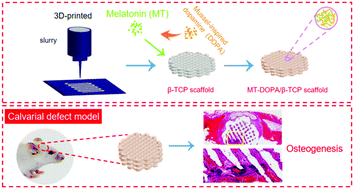Melatonin decorated 3D-printed beta-tricalcium phosphate scaffolds promoting bone regeneration in a rat calvarial defect model†
Abstract
Melatonin (MT) has been served as promising osteogenic factor to promote osteogenesis. However, the direct injection of MT is accompanied by its fast diffusion and rapid degradation, which can significantly affect the repairing of bone defects. The sustainable release of MT from scaffolds would greatly enhance bone regeneration, but it has never been studied. Herein, we have demonstrated the decoration of MT molecules into the 3D-printed beta-tricalcium phosphate (β-TCP) scaffolds by utilizing the dopamine-based mussel-inspired chemistry. The slower release of MT from the scaffolds was achieved, and bone mesenchymal stem cells demonstrated great viability and proliferation ability within the scaffolds. Remarkably, a significantly higher expression of osteogenic-genes was achieved in the MT decorated scaffolds in the presence of dopamine. These scaffolds were then implanted into rat calvarial defect sites for the in vivo bone regeneration investigation. Micro-computed tomography (micro-CT), bone mineral density and histological analysis clearly revealed that the scaffolds with MT decoration exhibited the highest percentage of new bone ingrowth. These results demonstrate that the decoration of MT into the 3D-printed β-TCP scaffolds could be a facile and highly efficient strategy to promote bone regeneration.



 Please wait while we load your content...
Please wait while we load your content...